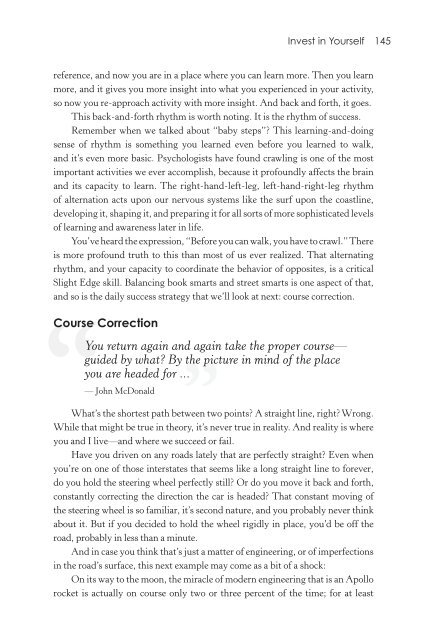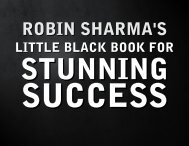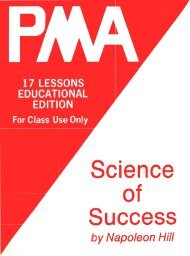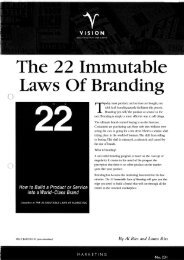The-Slight-Edge
Create successful ePaper yourself
Turn your PDF publications into a flip-book with our unique Google optimized e-Paper software.
invest in Yourself 145<br />
reference, and now you are in a place where you can learn more. <strong>The</strong>n you learn<br />
more, and it gives you more insight into what you experienced in your activity,<br />
so now you re-approach activity with more insight. And back and forth, it goes.<br />
This back-and-forth rhythm is worth noting. It is the rhythm of success.<br />
Remember when we talked about “baby steps”? This learning-and-doing<br />
sense of rhythm is something you learned even before you learned to walk,<br />
and it’s even more basic. Psychologists have found crawling is one of the most<br />
important activities we ever accomplish, because it profoundly affects the brain<br />
and its capacity to learn. <strong>The</strong> right-hand-left-leg, left-hand-right-leg rhythm<br />
of alternation acts upon our nervous systems like the surf upon the coastline,<br />
developing it, shaping it, and preparing it for all sorts of more sophisticated levels<br />
of learning and awareness later in life.<br />
You’ve heard the expression, “Before you can walk, you have to crawl.” <strong>The</strong>re<br />
is more profound truth to this than most of us ever realized. That alternating<br />
rhythm, and your capacity to coordinate the behavior of opposites, is a critical<br />
<strong>Slight</strong> <strong>Edge</strong> skill. Balancing book smarts and street smarts is one aspect of that,<br />
and so is the daily success strategy that we’ll look at next: course correction.<br />
Course Correction<br />
You return again and again take the proper course—<br />
guided by what? By the picture in mind of the place<br />
you are headed for ...<br />
— John McDonald<br />
What’s the shortest path between two points? A straight line, right? Wrong.<br />
While that might be true in theory, it’s never true in reality. And reality is where<br />
you and I live—and where we succeed or fail.<br />
Have you driven on any roads lately that are perfectly straight? Even when<br />
you’re on one of those interstates that seems like a long straight line to forever,<br />
do you hold the steering wheel perfectly still? Or do you move it back and forth,<br />
constantly correcting the direction the car is headed? That constant moving of<br />
the steering wheel is so familiar, it’s second nature, and you probably never think<br />
about it. But if you decided to hold the wheel rigidly in place, you’d be off the<br />
road, probably in less than a minute.<br />
And in case you think that’s just a matter of engineering, or of imperfections<br />
in the road’s surface, this next example may come as a bit of a shock:<br />
On its way to the moon, the miracle of modern engineering that is an Apollo<br />
rocket is actually on course only two or three percent of the time; for at least













